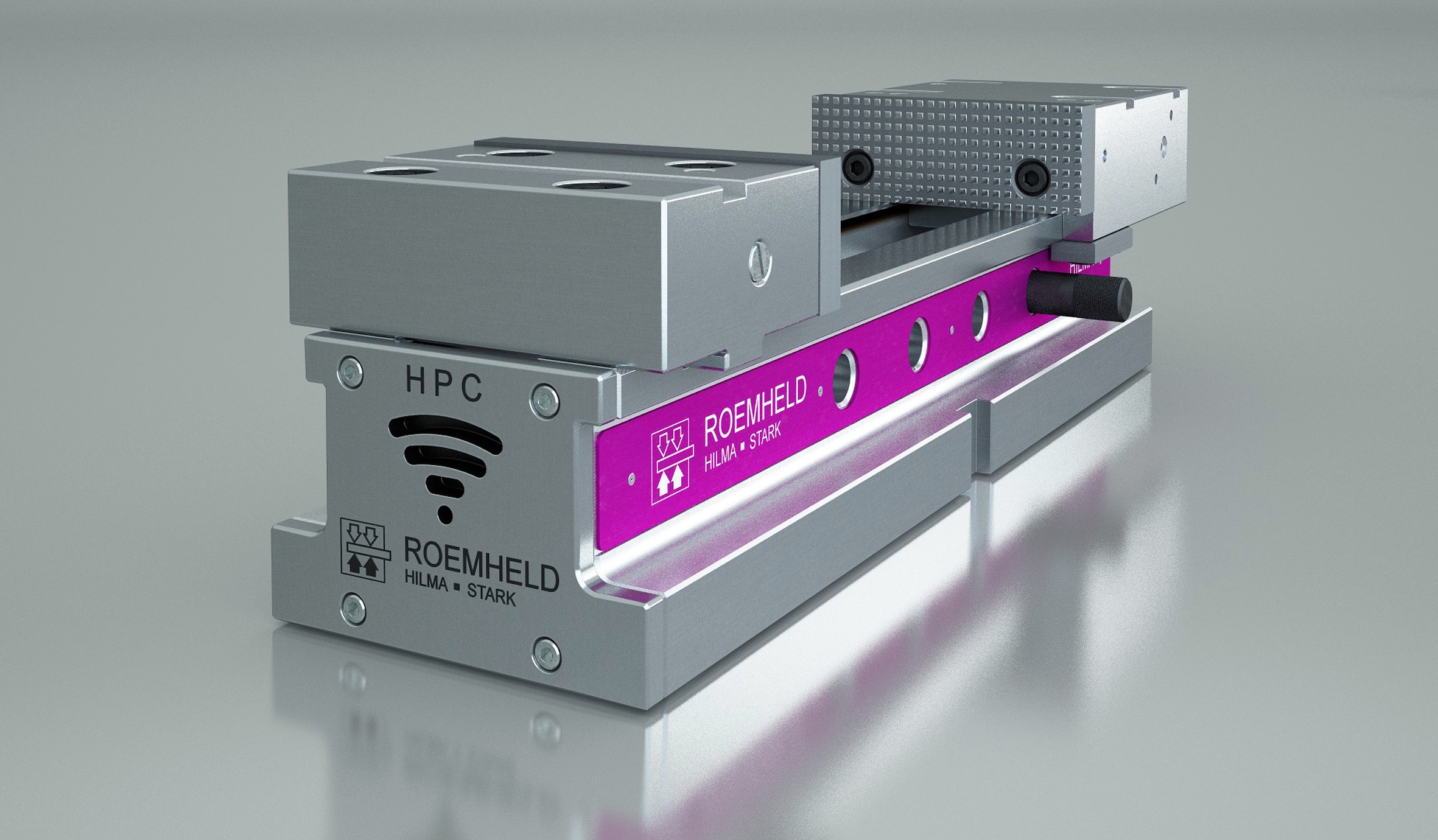“HILMA Process Control”: an intuitive app for sensory clamping elements
The ROEMHELD Group has developed the HPC machine vice with intelligent sensors for safe clamping of workpieces on machine tools and real-time production monitoring. The vice can be operated intuitively via an associated app. The clamping technology specialist is now presenting the recently completed prototype at the AMB. The HPC machine vice is the second ROEMHELD clamping element with integrated sensors after a sensory swing clamp presented in 2017. The group’s goal is to develop Industry 4.0 compatible clamping elements that increase the manufacturing quality in tool and workpiece clamping.
This innovation extends the functions of the proven HILMA NC 125 machine vice; its electronics measure clamping forces in real time. The clamping element compares them with pre-set target and limit values. The results are transmitted wirelessly to stationary or mobile receivers on which the associated app “HILMA Process Control” is installed. If the clamping force values approach one of the limit ranges, a warning is issued. The data can also be communicated to the machine control system for automated intervention in the production process. In addition to wireless transmission to the app, an OPC-UA interface is also used for data transmission. This corresponds to the industry 4.0 standard and enables direct data communication with a suitable machine.

With the machine vice HPC from ROEMHELD clamping forces can be monitored in real time
thanks to sensors.
Simple visualisation
The system measures with a cycle time of half a second and detects changes in clamping force from 50 N. The current values are transmitted wirelessly to the app, where they are readable and logged. They can also be controlled via an optical traffic light system in the app.
Green stands for optimum production. As soon as a clamping force value is measured at the edge of a set minimum or maximum range, the light switches to yellow and the operator can intervene. If a limit value is exceeded, the light lights up red. In this case, the machine can be switched off automatically.
Display of up to four HPC machine vices
The operator can conveniently determine for himself via the app at which clamping force value the system warns.
In the current version, he can use the app to control up to four clamping elements simultaneously, for which he can assign individual designations for differentiation.
In a clearly arranged operating screen, the operator determines an optimum value for machining the workpiece as well as a minimum and a maximum target value. He also specifies from which approximation to these two values a warning message is to be issued. In addition, he can easily calibrate the machine vice using the app. To protect the element against premature wear, overloads are signalled to the operator with regard to the nominal clamping force. The customer can check maintenance intervals via a load cycle counter.
Versatile application possibilities – also fully automated
The HPC monitoring system essentially consists of a circuit board on the clamping element and a battery, which are protected against swarf and cooling lubricants by a housing and meet the requirements of code class IP67. The monitoring system can operate on battery power and with a continuous power supply and will in future be available as an option for the mechanical-hydraulic and purely hydraulic versions of the HILMA NC 125.
A fully automatic operation is also possible with the hydraulically driven machine vice.
Further sensor projects planned
The machine vice HPC is already the second clamping element with intelligent sensors from ROEMHELD.
At the previous AMB in Stuttgart, the group presented a sensory swing clamp that was very well received by the trade audience. It measures, for example, the clamping pressure, the temperature and the cutting forces on the workpiece.
Further sensor projects are to follow in future. For this purpose, HILMA has designed the sensor system so that it can be used in the same form on other clamping elements. The app can also be rapidly expanded to monitor different types of clamping systems simultaneously.
About ROEMHELD:
Whether for aircraft, automobiles, machine tools or cases for smartphones: technologies and products of the ROEMHELD Group have been used to manufacture numerous industrial commodities and goods for end users for more than 60 years.
Efficient clamping technology solutions for workpieces, as well as for dies in forming technology and plastics processing, form the core of our ever-increasing portfolio. This is supplemented with components and systems for assembly and handling technology, drive technology and locking mechanisms for rotors on wind energy systems.
As well as a wide range of approximately 20,000 catalogue items, the ROEMHELD Group is also specialised in the development and realisation of customised solutions and is internationally respected as one of the market leaders for quality today.
Innovation through tradition: ROEMHELD was established in 1707 with a foundry in Friedrichshütte, which still belongs to the ROEMHELD Group today and counts as one of the oldest active industrial businesses in Germany.
The owner-managed group of companies employs approximately 560 workers in its three locations of Laubach, Hilchenbach and Rankweil/Austria, and is represented in over 50 countries by service and sales organisations. With customers from the mechanical engineering sector, as well as the automobile, aviation and agricultural industries, the ROEMHELD Group generates an annual turnover of more than 100 million Euro.


Leave A Comment
You must be logged in to post a comment.